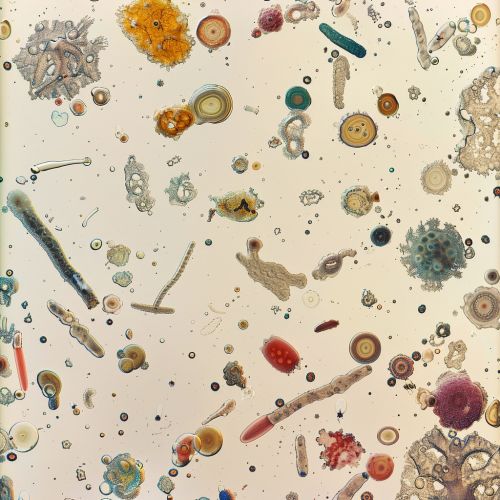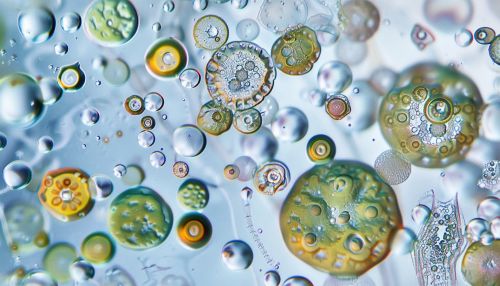Marine Microbiology: Difference between revisions
(Created page with "== Introduction == Marine microbiology is the study of microorganisms and their interactions in marine environments. This field encompasses a wide range of disciplines, including microbial ecology, physiology, genetics, and biochemistry, focusing on the roles of bacteria, archaea, viruses, fungi, and protists in ocean ecosystems. Marine microorganisms are critical to global biogeochemical cycles, marine food webs, and the health of marine organisms, making their study es...") |
No edit summary |
||
| (One intermediate revision by the same user not shown) | |||
| Line 84: | Line 84: | ||
* [[Symbiosis]] | * [[Symbiosis]] | ||
[[Image:Detail-93349.jpg|thumb|center|Microscopic view of diverse marine microorganisms in a water sample.|class=only_on_mobile]] | |||
[[Image:Detail-93350.jpg|thumb|center|Microscopic view of diverse marine microorganisms in a water sample.|class=only_on_desktop]] | |||
== References == | == References == | ||
Latest revision as of 10:02, 22 June 2024
Introduction
Marine microbiology is the study of microorganisms and their interactions in marine environments. This field encompasses a wide range of disciplines, including microbial ecology, physiology, genetics, and biochemistry, focusing on the roles of bacteria, archaea, viruses, fungi, and protists in ocean ecosystems. Marine microorganisms are critical to global biogeochemical cycles, marine food webs, and the health of marine organisms, making their study essential for understanding oceanic processes and environmental changes.
Historical Background
The field of marine microbiology has evolved significantly since its inception in the late 19th century. Early pioneers such as Antonie van Leeuwenhoek and Louis Pasteur laid the groundwork for microbial studies, but it wasn't until the development of more advanced microscopy and molecular techniques in the 20th century that marine microbiology truly began to flourish. The discovery of hydrothermal vent communities in the 1970s and the advent of metagenomics in the early 2000s have been particularly transformative, revealing the immense diversity and ecological importance of marine microorganisms.
Marine Microbial Diversity
Marine environments host a vast array of microorganisms, including:
Bacteria
Marine bacteria are incredibly diverse, with representatives from nearly all known bacterial phyla. They play crucial roles in nutrient cycling, organic matter decomposition, and symbiotic relationships with marine organisms. Notable groups include the Cyanobacteria, which are primary producers through photosynthesis, and the Proteobacteria, which include many important heterotrophic and chemolithoautotrophic species.
Archaea
Once thought to be restricted to extreme environments, marine archaea are now known to be abundant and diverse in the ocean. They are particularly important in nitrogen and carbon cycling. The discovery of Thaumarchaeota, a phylum of ammonia-oxidizing archaea, has highlighted their role in nitrification and their contribution to the marine nitrogen cycle.
Viruses
Marine viruses are the most abundant biological entities in the ocean, with estimates of 10^30 viruses globally. They play a critical role in controlling microbial populations through lysis, influencing nutrient cycling, and driving genetic exchange through horizontal gene transfer. Bacteriophages, viruses that infect bacteria, are particularly significant in regulating bacterial communities.
Fungi
Marine fungi, though less studied than bacteria and archaea, are important decomposers of organic matter and can form symbiotic relationships with marine plants and animals. They are involved in nutrient cycling, particularly in coastal and estuarine environments.
Protists
Marine protists, including diatoms, dinoflagellates, and foraminifera, are key components of the marine food web. They serve as primary producers, grazers, and predators, influencing the flow of energy and nutrients through marine ecosystems.
Marine Microbial Ecology
Marine microbial ecology examines the interactions between microorganisms and their environment, including biotic and abiotic factors. Key areas of study include:
Biogeochemical Cycles
Marine microorganisms are integral to global biogeochemical cycles, including the carbon, nitrogen, sulfur, and phosphorus cycles. They mediate processes such as photosynthesis, respiration, nitrification, denitrification, sulfate reduction, and methanogenesis, which are essential for maintaining the balance of these elements in the ocean.
Symbiosis
Symbiotic relationships between marine microorganisms and other marine organisms are widespread and diverse. Examples include the mutualistic associations between zooxanthellae (symbiotic dinoflagellates) and corals, which are crucial for coral reef health, and the symbiosis between chemoautotrophic bacteria and deep-sea hydrothermal vent animals, which rely on these bacteria for nutrition.
Microbial Food Webs
Marine microbial food webs describe the flow of energy and nutrients through microbial communities. Microbial loop processes, where dissolved organic matter is recycled by bacteria and subsequently consumed by protozoa and small metazoans, are central to the productivity of marine ecosystems.
Molecular Techniques in Marine Microbiology
Advances in molecular biology have revolutionized marine microbiology, enabling the study of microbial diversity and function at unprecedented levels of detail. Key techniques include:
Metagenomics
Metagenomics involves the direct analysis of genetic material from environmental samples, bypassing the need for culturing. This approach has revealed the vast diversity of marine microorganisms and their functional potential, providing insights into community structure, metabolic pathways, and ecological roles.
Transcriptomics
Transcriptomics examines the expression of genes in microbial communities, providing information on their functional activity in response to environmental conditions. This technique helps to elucidate the physiological responses of microorganisms to factors such as nutrient availability, temperature, and pH.
Proteomics
Proteomics analyzes the protein composition of microbial communities, offering insights into the functional proteins and enzymes involved in metabolic processes. This approach complements metagenomics and transcriptomics by linking genetic potential with actual biochemical activity.
Single-Cell Genomics
Single-cell genomics allows the study of individual microbial cells, providing high-resolution insights into the genetic and functional diversity within microbial populations. This technique is particularly useful for studying rare or unculturable microorganisms.
Marine Microbial Biotechnology
Marine microorganisms have significant biotechnological potential, with applications in various fields, including:
Pharmaceuticals
Marine microorganisms are a rich source of novel bioactive compounds with potential pharmaceutical applications. Examples include antibiotics, anticancer agents, and anti-inflammatory compounds. The unique metabolic pathways of marine microbes often lead to the production of structurally diverse and biologically active molecules.
Biofuels
Marine microorganisms, particularly algae and cyanobacteria, are being explored as sources of biofuels. These organisms can produce lipids and hydrocarbons that can be converted into biodiesel and other biofuels, offering a renewable and sustainable energy source.
Bioremediation
Marine microorganisms play a crucial role in the bioremediation of polluted marine environments. They can degrade pollutants such as hydrocarbons, heavy metals, and plastics, helping to mitigate the impact of human activities on marine ecosystems.
Aquaculture
Probiotics and other microbial products are increasingly used in aquaculture to enhance the health and growth of farmed marine organisms. These products can improve water quality, enhance nutrient availability, and protect against pathogens.
Challenges and Future Directions
Despite significant advances, marine microbiology faces several challenges, including:
Culturing Marine Microorganisms
A large proportion of marine microorganisms remain unculturable using traditional methods, limiting our understanding of their physiology and ecological roles. Developing new culturing techniques and optimizing existing ones are critical for advancing the field.
Environmental Change
Climate change, ocean acidification, and pollution pose significant threats to marine ecosystems and the microorganisms that inhabit them. Understanding how these stressors impact marine microbial communities and their functions is essential for predicting and mitigating their effects.
Integrative Approaches
Integrating data from multiple disciplines, such as genomics, ecology, and oceanography, is necessary to develop a holistic understanding of marine microbial processes. Collaborative efforts and interdisciplinary research are key to addressing complex questions in marine microbiology.
See Also


